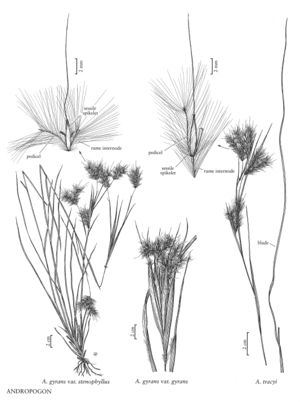Difference between revisions of "Andropogon tracyi"
FNA>Volume Importer |
FNA>Volume Importer |
(No difference)
| |
Revision as of 21:31, 16 December 2019
Plants cespitose, upper portion dense, cylindrical. Culms 50-120 cm; internodes not glaucous; branches mostly erect, straight. Sheaths smooth; ligules 0.2-0.5 mm, ciliate, cilia 0.2-0.8 mm; blades 10-22 cm long, 1.2-2.6 mm wide, glabrous or sparsely pubescent, with spreading hairs. Inflorescence units 3-11 per culm; subtending sheaths (2.8)4.1-5.8(7.2) cm long, (3)4-4.7(5.8) mm wide; peduncles (9)14-31(65) mm, with 2 rames; rames (1.5)2.4-3.6(4.2) cm, usually exserted at maturity, pubescence increasing in density distally within each internode. Sessile spikelets (4)4.8-5(5.5) mm; callus hairs 1.5-3.5 mm; keels of lower glumes scabrous only above the midpoint; awns 11-23 mm; anthers 1, 1.2-2 mm, yellow. Pedicellate spikelets vestigial or absent. 2n = 20.
Distribution
Ga., N.C., Ala., Miss., S.C., Fla.
Discussion
Andropogon tracyi grows on sandhills, sandy pinelands, and scrublands of the southeastern United States. It resembles A. longiberbis, but usually differs in having sparsely pubescent blades and a more slender appearance.
Selected References
None.
